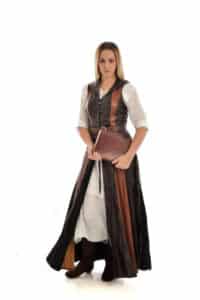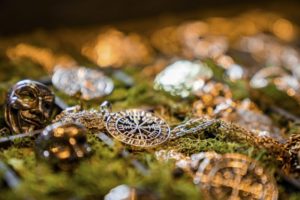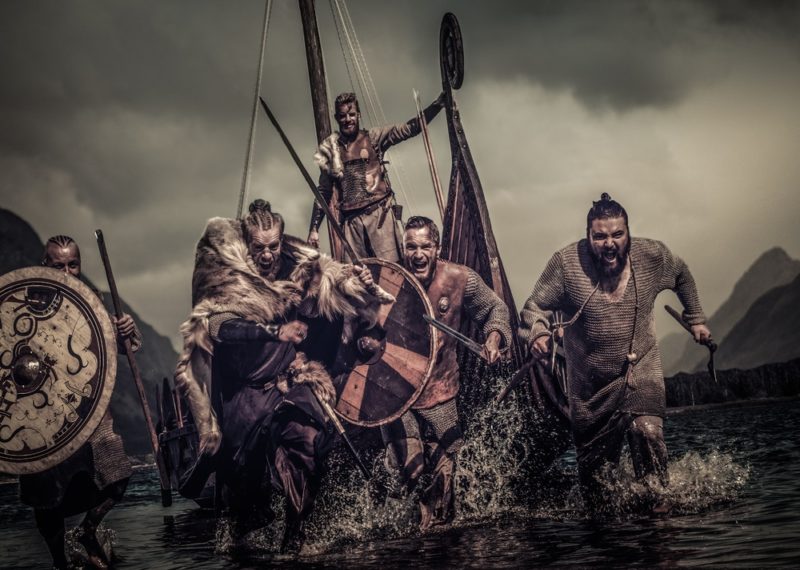The Vikings lived in ancient Scandanavia and were notorious for being ruthless warriors that ransacked towns in the Viking era. Because most people picture the Vikings as brutes, they often imagine that they couldn’t have had much sense of style when it came to clothing. However, archaic evidence shows that the Norse paid much attention to how they dressed.
If you are wondering what Viking warriors and commoners would typically wear in the Viking age, here is all you need to know.
How We Are Able to Tell What Vikings Wore During the Viking Age
Because of the scarcity of archaeological material, we only have a limited understanding of Viking clothing. Most of the time, fabrics and textiles are not preserved in burial sites. When pieces of fabric are discovered, they are typically small and have deteriorated.

However, literary material such as the Norse sagas could also be used to determine what Vikings wore. We can put together a reasonably precise portrayal of Viking attire using archaeological information and historical Viking data.
What Did Viking Women Wear?
If you are wondering how Viking women dressed, here is a detailed description of what an ancient Nordic woman may have been seen wearing.

Typical Viking Clothing Worn by Women
Viking women typically wore long dresses with straps that included an undergarment or a smock beneath. The dress was likely form-fitting and made by sewing together coarse fabrics. It had sides that were either open or stitched together.
Gussets might also have been stitched into the garment to give it more form. It also included a single strap for each shoulder that held it up over the bosom, and a brooch would have been used to secure the strap at the front. A thread of beads was frequently strung between the brooches attached to each strap.
Fashionable Undergarments
According to research, Danish Viking women favored plain undergarments, which were worn underneath their strap dresses, whereas Swedish Viking women favored pleated underwear. This indicates that there was even fashion related to undergarments!
Cloaks Covered Their Shoulders
A cloak was also typically worn over the strap dress to cover the shoulders. It would be secured with a little trilobite or round brooch and provided a unique neck style. Many Viking cloaks and dresses had weaved edges and fur strips that were added as decorative elements.
Accessories
A Viking woman would also be seen adorning her waist with a belt that had small leather pouches. These pouches served a functional purpose and were used to store small objects such as sewing needles and silver coins.

Women Also Wore Leather Boots
The truth is that for many years, leather boots were associated with men. However, evidence shows that Viking women also sported leather boots.
What Did Viking Men Wear?
If you are wondering what male Vikings wear, here is everything you need to know.
Overall Attire
A tunic, pants, and cloak were common Viking male attire. The tunic resembled a long sleeve length. It did not have any buttons like modern-day shirts do and could be worn at knee length.
Viking Cloaks Fastened by a Brooch
The Viking man also donned a cloak held together with a metal brooch. Vikings frequently crafted these brooches to serve a functional and decorative purpose.
Typically, the man’s cloak would be gathered around his arm, which he used to draw his weapon, which would typically be an ax or a sword. This was a great way to tell whether a Viking was right or left-handed.
Viking Trousers
The design or style of the trousers is something we don’t know much about. They looked like plus fours with the knees gathered together. Puttees or socks were typically wrapped around the shins. Puttees are a type of legwarmer. It is essentially a lengthy, thin strip of fabric wrapped around the person’s legs to provide warmth.
Accessories
Men used belts or had thread wrapped around their waists to keep their garments up because their clothing contained no elastic, buttons, or pockets. The man would typically be wearing a money bag or a blade on his belt.
Viking Warriors
The Viking warrior was equipped with weaponry in addition to his Viking clothing. A sword, spear, ax, helmet, shield, and lance are examples of such weapons. Iron was costly in the Viking Age, and not every warrior had a complete set of weapons.
Understanding Foot Style: Viking Shoes
Viking shoes were typically ankle-high, and boots were also donned. The ‘turnshoe’ method was used to make both of them from leather. It entailed making the footwear from the inside out, stitching it, and then pulling it through to its finished state. Shoemakers probably used toggles to secure the shoes, which they could modify for a better fit.
Even though the shoes were commonly made using leather, they only lasted a few weeks and never more than a year. Due to wear and tear, the sole would most likely need to be replaced.
Environmental Influences on Nordic Fashion
The atmosphere was rough, frigid, and cruel during the Viking age. Naturally, the cold weather affected the clothing that the Norse wore.
Because of the fierce winters, any clothes they wore had to protect them from these extreme weather conditions during the winter. However, they had to be functional and adaptable to wear for the day-to-day jobs they had to complete.
The Germanic inhabitants of northern parts of Europe are thought to have worn attire similar to or identical to that worn by the Vikings. There is a difference between the kinds of clothes worn by males and those worn by women. Wealth and social status influenced their clothing choices as well.
Final Thoughts
It’s fascinating to learn about civilizations that lived before us. The ancient Scandanavian Viking nation is well-understood thanks to archaeological findings from gravesites and the Viking history recorded for us in Noric Sagas and other historical texts.
The tradition of dressing as a Viking is still prominent today, so if you are looking for similar clothing, there are several online stores dedicated to keeping the Viking culture alive.
Frequently Asked Questions
Here are some of the answers to your most asked questions about Viking clothes.
1. How Did the Norse Color Their Clothing?
Viking clothes were typically made in a variety of colors. During the Viking Age, colored yarn could be made by boiling the fabric or cloth with various color-producing plants. Blue, red, yellow, and purple are colors that researchers believe were prevalent in Viking Age clothing.
Blue has only been discovered in the graves of wealthy people, indicating that it was a costly hue. This is because this color is thought to have come from either a native plant called woad or an imported dye called indigo, which commoners couldn’t typically afford.
2. What Fabrics Did the Vikings Use?
Flax has been discovered in approximately 40 percent of Viking clothing found in burial sites. This means that flax was a significant plant in the Viking clothing industry. According to research, over 44 pounds of flax plants were required to generate enough cloth for a tunic.
Furthermore, the task took approximately 400 hours to complete, from the time the flax was planted to the time the tunic was made. Numerous sites where flax was manufactured on a near-industrial scale have been discovered in Denmark and possibly played a major role in Viking trade.
3. Did the Norse Wear Jewelry?
Armbands, necklaces, and brooches were worn by women and men from all socioeconomic levels during the Viking era. Some of the jewelry was merely decorative, but those made from precious metals were a sign of riches.
Other things, such as brooches, had a practical use. They ensured that Viking cloaks fastened. There were also jewelry items with symbolic significance used by the Norse, including Thor’s hammers.




